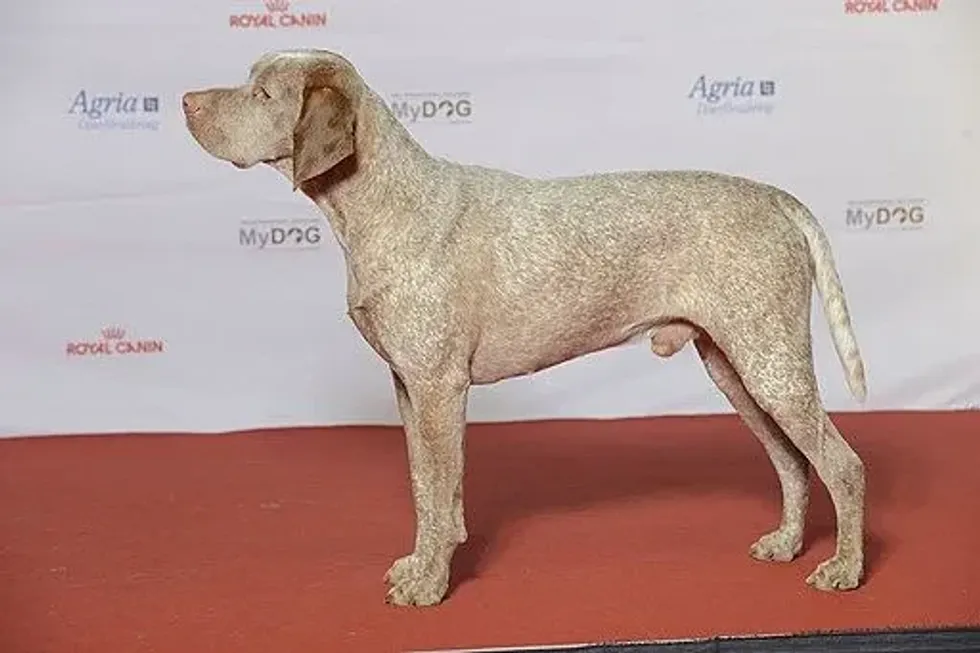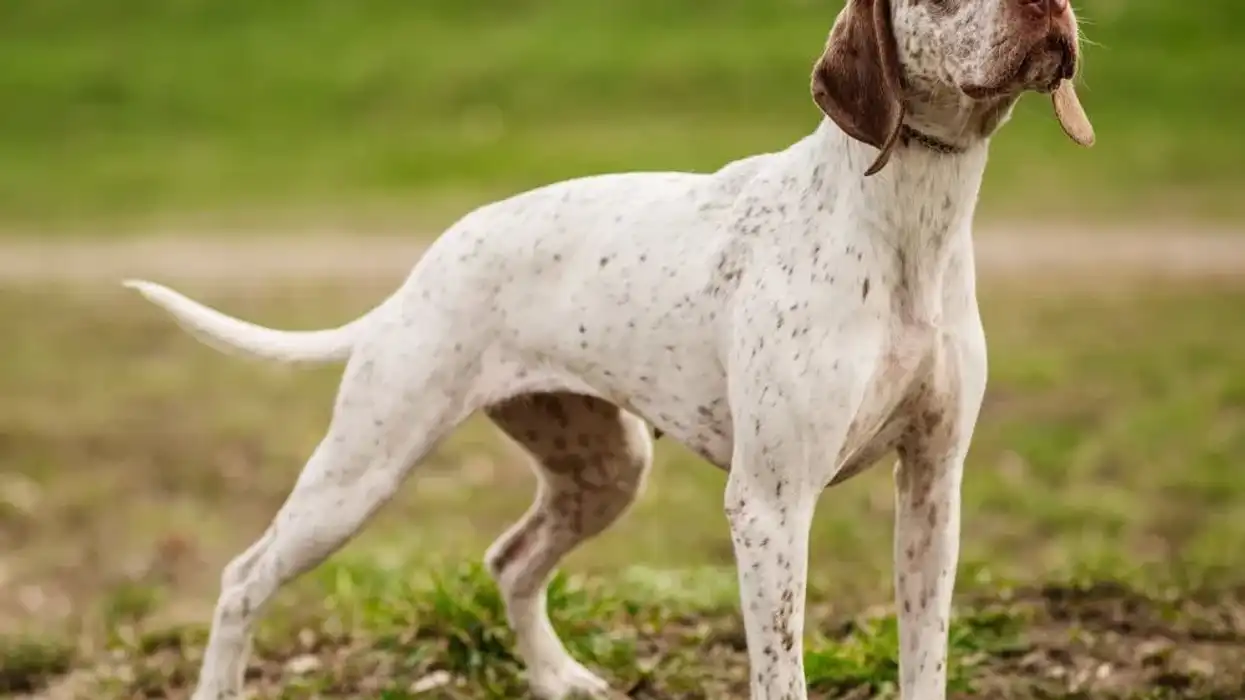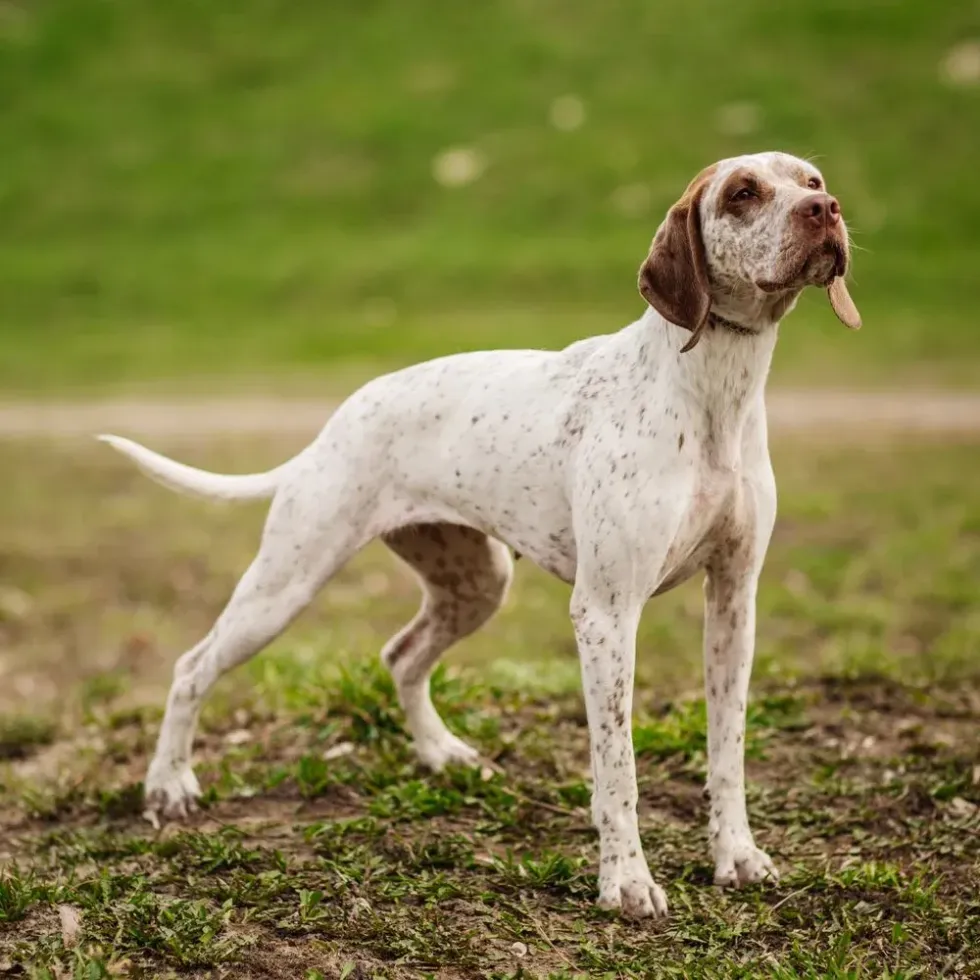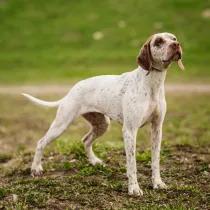Fun Braques Du Bourbonnais Facts For Kids
Content
- What type of animal is a Braque du Bourbonnais?
- What class of animal does a Braque du Bourbonnais belong to?
- How many Braque du Bourbonnais are there in the world?
- Where does a Braque du bourbonnais live?
- What is a Braque du Bourbonnais's habitat?
- Who do Braque du Bourbonnais live with?
- How long does a Braque du Bourbonnais live?
- How do they reproduce?
- What is their conservation status?
- What do Braque du Bourbonnais look like?
- How cute are they?
- How do they communicate?
- How big is a Braque du Bourbonnais?
- How fast can a Braque du Bourbonnais run?
- How much does a Braque du Bourbonnais weigh?
- What are the male and female names of the species?
- What would you call a baby Braque du Bourbonnais?
- What do they eat?
- Are they slobbery?
- Would they make a good pet?
- Did you know...
- What is the temperament of Braque du Bourbonnais dog?
- Is Braque du Bourbonnais a hunter dog?
The word 'Braque' in French means 'to point'. Hunters use pointer dog breeds for their ability to search for prey and point towards it with their muzzles.
First seen in the 15th century in France, Braque du Bourbonnais is one of the oldest pointer breeds. It is a gun dog from the province of Bourbonnais in France. This rare breed is also known as the Bourbonnais pointing dog, Bourbonnais pointer, or French pointer.
The Bourbonnais pointing dog was well known for its ability to point, track and retrieve prey. French hunters would take them along as gun dogs. Today, the breed is well established in the United States.
Braques du Bourbonnais is a calm, friendly, and affectionate creature who do quite well in families with children. Now they are also being adopted as companion dogs. These loving, high-energy dogs make wonderful pets, but they need to be close to their family most of the time, and they need space to run and play.
These dogs enjoy good health with life spans of up to 15 years. But like some other breeds, they do face some health concerns like hip dysplasia, pulmonic stenosis of the heart, and entropion or ectropion.
For more relatable content, check out these American Eskimo dog facts and Flat-coated Retriever facts for kids.
Braque Du Bourbonnais Interesting Facts
What type of animal is a Braque du Bourbonnais?
The Braque du Bourbonnais is a breed of dog.
What class of animal does a Braque du Bourbonnais belong to?
The Braque du Bourbonnais dog belongs to the Mammalia class.
How many Braque du Bourbonnais are there in the world?
An accurate count is not available.
Where does a Braque du bourbonnais live?
A Braque du Bourbonnais dog usually lives in a house with people. These dogs are extremely energetic and therefore they require a lot of daily exercise. Exercise is important to their physical and mental health. They are not suited to life in an apartment. They do better living in a house with a yard or garden.
What is a Braque du Bourbonnais's habitat?
The Braque du Bourbonnais’s short coat makes it unable to handle extreme weather conditions. These dogs are best suited to living in the countryside or in hilly areas with a mild or temperate climate.
Who do Braque du Bourbonnais live with?
Braques du Bourbonnais usually live with people. This dog enjoys being close to its family members and doesn’t like being left alone.
How long does a Braque du Bourbonnais live?
The Braque du Bourbonnais dog breed doesn’t have any major health problems and usually enjoys a life span of 13-15 years.
How do they reproduce?
Like other dogs, Braque du Bourbonnais reproduce through sexual intercourse. The normal gestation period is usually 63-65 days. Gestating females give birth to litters with three to six puppies.
What is their conservation status?
The Braque du Bourbonnais breed is a domestic dog. Domesticated dogs aren’t considered to be under threat.
Braque Du Bourbonnais Fun Facts
What do Braque du Bourbonnais look like?

Like other pointing breeds, Braques du Bourbonnais are medium-sized, athletic dogs. Their legs especially are very muscular. Despite this, these dogs are very graceful in appearance. Females have slightly thinner and longer bodies than males.
Dogs of this breed have a short coat with thick, fine fur. Their short fur means that they require very little grooming to maintain their coat. Their coloring is usually white with brown (liver or chestnut) or fawn-colored ticking on their bodies.
These colors are also referred to as 'faded lilac' or 'peach blossom' by breeders. Ticking is very small spots of color on areas with white fur. This distinctive brown or fawn ticking is what makes the Braque du Bourbonnais unique among other pointer dog breeds.
These dogs have a pear-shaped head, and large, expressive, round eyes. Their nose and eye color generally match the shade of brown in their coat. Their medium-sized ears hang down to their throats. Some dogs are born without a tail, or with a short tail.
How cute are they?
Like all puppies, puppies of the Braque du Bourbonnais breed are totally adorable. They are born completely white, and their spots become visible only after a few weeks. Adult Braque du Bourbonnais dogs have graceful and athletic bodies, similar to other pointing breeds. They have kind faces with large eyes and floppy ears.
How do they communicate?
One of the key ways that a pointing dog communicates with hunters is by using its nose to point towards prey. The French Pointer dog is also an excellent tracker. It can use its keen sense of smell to search for prey.
Braques du Bourbonnais also communicate with humans and other dogs by barking, smelling, licking to show affection, and jumping to ask for cuddles. They use a variety of sounds to communicate different things.
Whines and whimpers can show fear, while growls can mean 'back off'! They also communicate through the movements of their ears and tails, such as wagging their tails to show happiness and excitement.
Braque du Bourbonnais is an intelligent breed. With some training, these dogs can understand signals from their humans. These can be in the form of verbal commands, hand signals, different kinds of touch, and posture. Apart from this, most dogs are sensitive creatures who can distinguish between different human facial expressions and gestures.
How big is a Braque du Bourbonnais?
Male Braque du Bourbonnais dogs are 20-22.4 in (51-57 cm) at the shoulder and bitches are 19-21.7 in (48-55 cm) at the shoulder. This makes dogs of this breed about twice as tall as a pug but a bit shorter than Dogo Argentino.
How fast can a Braque du Bourbonnais run?
Unfortunately, there is no official data about the running speed of the Braque du Bourbonnais.
How much does a Braque du Bourbonnais weigh?
Male Braque du Bourbonnais usually weigh 40-55 lb (18-25 kg). Females are a little bit lighter and usually weigh 35-48 lb (15.8-21.8 kg). The Northern Inuit dog is twice their size while a bull terrier is three times smaller than them.
What are the male and female names of the species?
Male Braque du Bourbonnais are called dogs and females are called bitches.
What would you call a baby Braque du Bourbonnais?
A baby Braque du Bourbonnais is called a puppy.
What do they eat?
Braques du Bourbonnais generally eat dog food that is either bought from a store or prepared at home by their human family. Since this is a breed of hunting dog with high energy requirements, they need a good quality diet to maintain their health.
Their dietary requirements also change with age. They will need different kinds of foods in early life than an adult or senior dog.
Are they slobbery?
No, unlike some larger breeds, the Braque du Bourbonnais breed is not slobbery. But these dogs do enjoy a lot of time outdoors, so they’ll need some regular grooming to keep their coat clean and nails trimmed.
Would they make a good pet?
The Braque du Bourbonnais breed is affectionate and good-natured, but despite these characteristics, they are not for everyone. The Braque du Bourbonnais will bond closely with its humans and has a strong need to be around family members.
This breed is better suited to large households where someone is likely to be at home all the time, as they can develop separation anxiety when left alone. For this reason, these dogs also prefer to stay indoors during the night rather than sleeping in a kennel outside.
Because they were bred for hunting, these are active dogs with a high need for daily exercise. They need regular time outdoors.
Besides walks, this breed needs multiple play sessions in a day. Most dogs will require at least one hour of intense exercise per day, which can include running, fetching, swimming, or even mountain climbing! For this reason, they would not do well in an apartment and are best suited to homes with big gardens or yards.
These are the two main factors that determine whether dogs of this breed will do well in a particular home or not. Braque du Bourbonnais dogs need loving attention from their family and an active lifestyle with plenty of exercise.
If they don’t get this, their mental and physical health may be affected. They can become depressed and develop behavioral problems. They might become destructive or disobedient as a way of communicating their unhappiness.
Dogs of this breed have a lot of energy and are eager to play with children and are generally friendly towards strangers. This means they probably won’t do well as guard dogs!
On the whole, they’re intelligent, obedient dogs. Training them is easy as they like to make their humans happy. They also require very little grooming because of their short coat.
Socialization in early life is key to a well-adjusted dog. If a Braque du Bourbonnais has enjoyed the company of other animals during its puppy days, it’s likely to be friendly to other dogs as adults.
They can be gradually introduced to other family pets like cats, and training can help them happily coexist.
However, they enjoy hunting and will probably have the urge to chase small animals like birds and rodents. So you should keep them on a leash most of the time so that your other pets and stray animals are protected!
Did you know...
The breed almost went extinct during World War I (1914-1918).
Soon after the war, a group of breeders in France established the first Club du Braque du Bourbonnais. But World War II (1939-1945) undid a lot of their work.
This, along with the strict breed standard that was focused on the dogs’ appearance, made it difficult for the breed to continue. Sadly, for a whole decade, no new Braque du Bourbonnais pups were registered.
In the early 1970s, a man named Michel Comte went in search of the remaining members of the breed. He began working with other breeders to restore the breed to its former popularity.
In 1982, he created a second Club du Braque du Bourbonnais. His efforts resulted in more pups being bred, and the breed was revived. Michel Comte remained the president of the club until 2001.
In 1988, the first Braque du Bourbonnais dog made its way from France to the United States. Since then, the breed has become very popular there.
While the breed is not recognized by the American Kennel Club (AKC), it is accepted for recording in the AKC Foundation Stock Service. The Foundation Stock Service is a service offered by the American Kennel Club to allow purebred breeds to reliably maintain their records.
Now, there are sometimes more Braque du Bourbonnais pups born in the United States than there are in France!
What is the temperament of Braque du Bourbonnais dog?
As with all dog breeds, each individual Braque du Bourbonnais dog has its own temperament and characteristics. But in general, these tend to be sweet, kind, and affectionate creatures. These are some of the qualities that make people fall in love with this breed.
The Braque du Bourbonnais is usually very attached to its family and routine and needs human companionship to be available most of the time. In fact, some dogs develop severe separation anxiety if they are left alone at home for long periods.
Since they are bred for hunting, they also need to be with families that have active lifestyles so that they can get adequate exercise. If these needs are not met, the dogs can become destructive.
This breed of dog needs a strong, firm human leader. They love to please their humans. Training them is easy with the use of verbal praise, treats, toys, and playtime. They quickly understand what’s expected of them, and are eager to comply. These dogs are sensitive to stress and don’t respond well to being punished or scolded.
A Braque du Bourbonnais dog is a good companion for families with children. With proper socialization in early life, they also get along well with other dogs and are friendly towards everyone they meet.
Is Braque du Bourbonnais a hunter dog?
Yes, the Braque du Bourbonnais makes an excellent companion for hunters. The French breeders of the Braque du Bourbonnais originally intended it to be a hunting dog. This is an active, energetic dog that enjoys working as a gun dog.
They help hunters search for prey, pointing to it with their noses. They are cooperative and intelligent in temperament and adapt easily to the needs of the hunt. They are also highly attentive and require very little training to pick up on cues provided by their humans.
Here at Kidadl, we have carefully created lots of interesting family-friendly animal facts for everyone to discover! Learn more about some other mammals from our false killer whale facts and Shikoku dog facts pages.
You can even occupy yourself at home by coloring in one of our dog mask coloring pages.
We Want Your Photos!
More for You
See All
Master of Computer Science

Abhijeet ModiMaster of Computer Science
An experienced and innovative entrepreneur and creative writer, Abhijeet holds a Bachelor's and Master's degree in Computer Application from Birla Institute of Technology, Jaipur. He co-founded an e-commerce website while developing his skills in content writing, making him an expert in creating blog posts, website content, product descriptions, landing pages, and editing articles. Passionate about pushing his limits, Abhijeet brings both technical expertise and creative flair to his work.
Disclaimer
1) Kidadl is independent and to make our service free to you the reader we are supported by advertising. We hope you love our recommendations for products and services! What we suggest is selected independently by the Kidadl team. If you purchase using the Buy Now button we may earn a small commission. This does not influence our choices. Prices are correct and items are available at the time the article was published but we cannot guarantee that on the time of reading. Please note that Kidadl is a participant in the Amazon Services LLC Associates Program, an affiliate advertising program designed to provide a means for sites to earn advertising fees by advertising and linking to Amazon. We also link to other websites, but are not responsible for their content.
2) At Kidadl, we strive to recommend the very best activities and events. We will always aim to give you accurate information at the date of publication - however, information does change, so it’s important you do your own research, double-check and make the decision that is right for your family. We recognise that not all activities and ideas are appropriate for all children and families or in all circumstances. Our recommended activities are based on age but these are a guide. We recommend that these ideas are used as inspiration, that ideas are undertaken with appropriate adult supervision, and that each adult uses their own discretion and knowledge of their children to consider the safety and suitability. Kidadl cannot accept liability for the execution of these ideas, and parental supervision is advised at all times, as safety is paramount. Anyone using the information provided by Kidadl does so at their own risk and we can not accept liability if things go wrong.
3) Because we are an educational resource, we have quotes and facts about a range of historical and modern figures. We do not endorse the actions of or rhetoric of all the people included in these collections, but we think they are important for growing minds to learn about under the guidance of parents or guardians.







